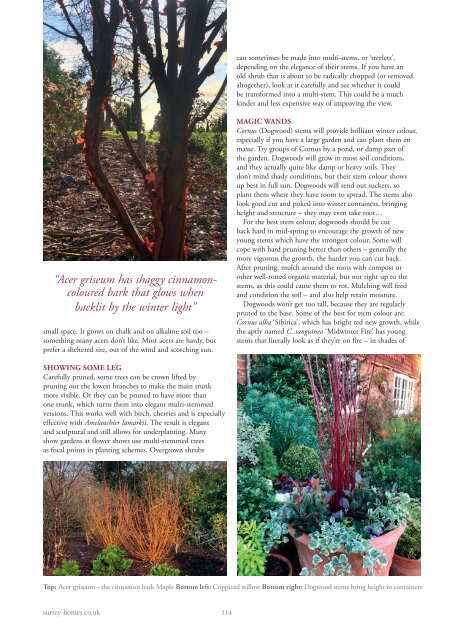Surrey Homes | SH64 | February 2020 | Interiors supplement inside
The lifestyle magazine for Surrey - Inspirational Interiors, Fabulous Fashion, Delicious Dishes
The lifestyle magazine for Surrey - Inspirational Interiors, Fabulous Fashion, Delicious Dishes
You also want an ePaper? Increase the reach of your titles
YUMPU automatically turns print PDFs into web optimized ePapers that Google loves.
can sometimes be made into multi-stems, or ‘treelets’,<br />
depending on the elegance of their stems. If you have an<br />
old shrub that is about to be radically chopped (or removed<br />
altogether), look at it carefully and see whether it could<br />
be transformed into a multi-stem. This could be a much<br />
kinder and less expensive way of improving the view.<br />
“Acer griseum has shaggy cinnamoncoloured<br />
bark that glows when<br />
backlit by the winter light”<br />
small space. It grows on chalk and on alkaline soil too –<br />
something many acers don’t like. Most acers are hardy, but<br />
prefer a sheltered site, out of the wind and scorching sun.<br />
MAGIC WANDS<br />
Cornus (Dogwood) stems will provide brilliant winter colour,<br />
especially if you have a large garden and can plant them en<br />
masse. Try groups of Cornus by a pond, or damp part of<br />
the garden. Dogwoods will grow in most soil conditions,<br />
and they actually quite like damp or heavy soils. They<br />
don’t mind shady conditions, but their stem colour shows<br />
up best in full sun. Dogwoods will send out suckers, so<br />
plant them where they have room to spread. The stems also<br />
look good cut and poked into winter containers, bringing<br />
height and structure – they may even take root…<br />
For the best stem colour, dogwoods should be cut<br />
back hard in mid-spring to encourage the growth of new<br />
young stems which have the strongest colour. Some will<br />
cope with hard pruning better than others – generally the<br />
more vigorous the growth, the harder you can cut back.<br />
After pruning, mulch around the roots with compost or<br />
other well-rotted organic material, but not right up to the<br />
stems, as this could cause them to rot. Mulching will feed<br />
and condition the soil – and also help retain moisture.<br />
Dogwoods won’t get too tall, because they are regularly<br />
pruned to the base. Some of the best for stem colour are:<br />
Cornus alba ‘Sibirica’, which has bright red new growth, while<br />
the aptly named C. sanguinea ‘Midwinter Fire’ has young<br />
stems that literally look as if they’re on fire – in shades of<br />
SHOWING SOME LEG<br />
Carefully pruned, some trees can be crown lifted by<br />
pruning out the lowest branches to make the main trunk<br />
more visible. Or they can be pruned to have more than<br />
one trunk, which turns them into elegant multi-stemmed<br />
versions. This works well with birch, cherries and is especially<br />
effective with Amelanchier lamarkii. The result is elegant<br />
and sculptural and still allows for underplanting. Many<br />
show gardens at flower shows use multi-stemmed trees<br />
as focal points in planting schemes. Overgrown shrubs<br />
Top: Acer griseum – the cinnamon bark Maple Bottom left: Coppiced willow Bottom right: Dogwood stems bring height to containers<br />
surrey-homes.co.uk<br />
114


















